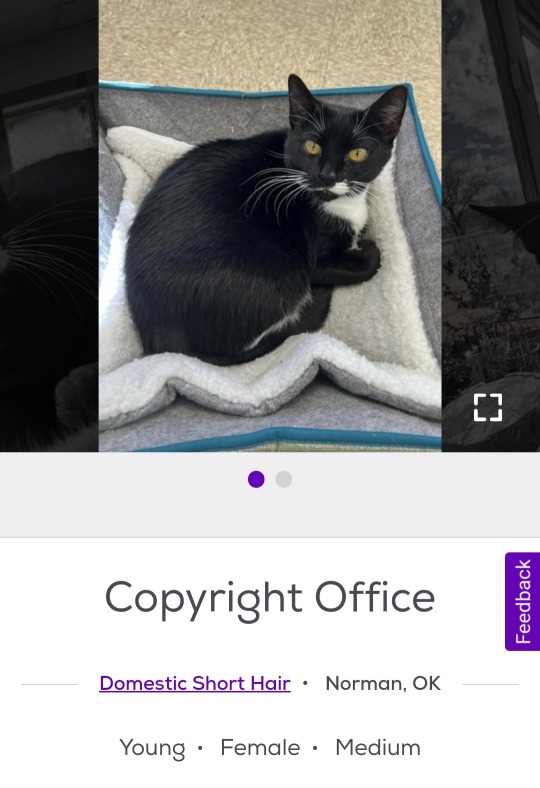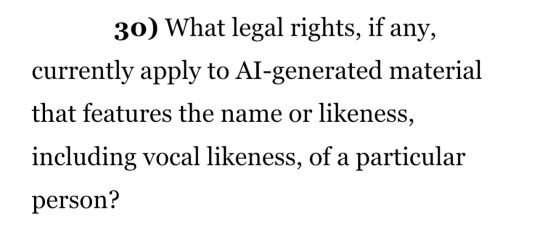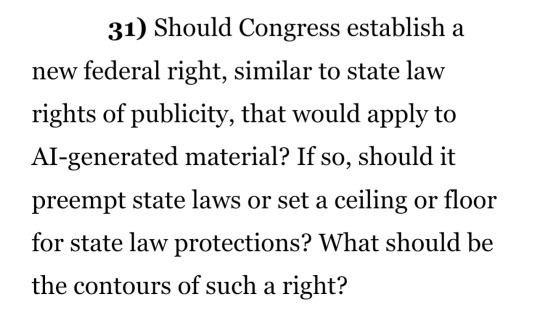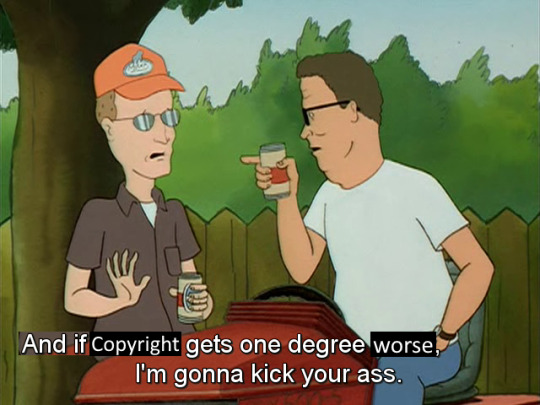#copyright office
Text

488 notes
·
View notes
Text
🚨ATTENTION ALL ARTISTS, WRITERS, & CREATIVES🚨 You have ‘til 10/30, 9PM PST TO LET THE COPYRIGHT OFFICE KNOW YOUR THOUGHTS ABOUT AI 🤖
They want answers on all kinds of questions, like training datasets ingesting creatives' works or the copyrightability of outputs. Here’s a guide I transcribed from my Twitter on how to get started:
On the comment submission page, there is the “Notice of Inquiry” document where the Office literally gives you what questions they want answers to (p12-21) - and there’s a LOT of them. Like, 50 at least. (It’s honestly so prohibitive to the average creative, which is why I made this guide). You DON’T have to answer every single question - just pick the ones that speak to you the most or ones you understand the best! To make it easier, here’s an edited list of questions that are most relevant for creatives
You DON’T have to be based in the US to submit a comment. In fact, the Office asks for examples of how other countries approach copyright & AI (Q#4), so if you live in places like Britain, Japan, etc. that have made major moves in those areas (for better or worse), leave a comment!
Below are some important questions for actors and VAs in particular. Though voice and likeness aren’t generally protected by copyright law, the Office is interested in hearing how AI may be impacted by state laws involving right of publicity or unfair competition (Q#30, Q#31).


📝WRITING TIPS📝
The Copyright Office’s goal is to create the best policy. Be clear, be constructive, and explain the reasoning behind your position. Wherever possible, counter the other side’s arguments. One well supported comment is more influential than 1000 copy paste ones!
Provide evidence - facts, expert opinions, your personal experience. How is AI already impacting you? Your industry? How will it impact you in the future? What are some stories you've seen in the news or social media about AI?
The Office is also VERY interested in any papers or studies relevant to AI and copyright (Q #3), so feel free to include a link to this incredibly informative paper on AI’s impact on artists
Be sure to mention any relevant personal or professional experience and credentials to lend more weight to your arguments, i.e. # of years drawing, years in the industry, major projects, awards won, union membership, etc
Here are some solid comments submitted by artist Kelly McKernan and screenwriter Bill Wolkoff if you want to see some examples
OTHER TIPS (courtesy of my ADHD brain): Schedule a block of time to write your thoughts out! Coordinate a little sesh with your friends! Keep a copy of your work in a separate doc! It’s so important that we get our concerns and ideas out there 💪
YOUR COMMENTS will not only inform the Office’s own work in determining what protections creatives may receive in the face of AI, but also inform their advice to Congress on potential generative AI legislation - so make your voices heard and SPREAD THE WORD! 📢📢📢
If you want to stay informed on this issue, particularly as it concerns visual artists, I highly recommend you follow @kortizart @ZakugaMignon @stealcase @chiefluddite @JonLamArt @ravenben @human_artistry on twitter and AI ML Advocacy on Insta (I don’t know of any tumblr blogs that actively follow this issue, so please reblog/comment below if you do!)
You also may know about the Concept Artist Association’s GoFundMe to represent artist voices in government - they made some big moves in the regulatory and congressional space, and are now fundraising for year two! 🙌🙌🙌
tagging some very cool creatives I follow that I believe care about how AI impacts their craft so this post doesn't die in the tumblr void 🫡
@neil-gaiman @geneslovee @anarchistfrogposting @pimientosdulces @sabertoothwalrus @simkjrs @loish @waneella @tunabuna @writing-prompt-s @logicalbookthief @bedupolker
#create don't scrape#no ai#artists on tumblr#illustrators on tumblr#copyright#writers on tumblr#writers on ao3#writerscommunity#ao3 fanfic#poetry#poems#graphic design#concept art#character design#copyright office#background art#visdev#visual novel#storyboard#animatic#this is what i've been doing instead of art LMAOOOOOOOO#pain.
47 notes
·
View notes
Text
So, the US Copyright Office is asking for public input about the whole issue of copyright and AI art, and as someone who's not a fan of modern copyright overreach, but with the rise of this issue also feels like I have been abandoned by God in this respect because it feels like everyone just started suddenly turning like the Pod People in Invasion of the Body Snatchers and start shrieking at me when I'm consistent with my values...
...Well, let's just say I'm kinda nervous. But, I recall enough of you hate copyright that you might as well be able to help, so I may as well boost.
My views on it, which I will submit:
Limiting fair use to stop the harvesting of AI data would have huge after-effects, both allowing only megacorps with their own proprietary models to use these tools and also likely being abused by these same megacorps to shut down independent artists.
This is also true for laws forcing the purgation of models using previously mass-harvested data, the havoc it would wreak would be unfathomable and I could easily see that abused to further attack sites like the Internet Archive.
I think there is room to consider models finetuned on a singular living creator/artist's style non-consentually as non-fair-use, that would be reasonable, but no further than that.
The way non-consentual inclusion in datasets should be handled is through expanding online privacy laws rather than copyright law, because this is a privacy issue and always should have been a privacy issue, and you need to tell Chuck Schumer to stop serving as a lobbyist cumdumpster and actually pass some privacy laws that aren't "Think of the Children"-type garbage like KOSA or EARN IT.
Copyrighting artstyle would be an unfathomably terrible idea that would make the visual art world as much of a copyright hellscape as the music world and destroy the livelihoods of all traditional artists who utilize pastiche at all, DO NOT DO THIS, NO MATTER WHAT ADOBE SAYS.
The idea that purely AI-generated works are automatically public domain should be explicitly placed into law, and in fact stringent standards should be created for what counts as "human input" so that megacorps don't find loopholes to still displace workers while still keeping copyright on their AI creations, because "pure" AI art being auto-PD is potentially a major tool to prevent worker displacement and should be used for such.
Finally:

52 notes
·
View notes
Text
Protection for Voice Actors is Artificial in Today’s Artificial Intelligence World
Protection for Voice Actors is Artificial in Today’s Artificial Intelligence World
As we all know, social media has taken the world by storm. Unsurprisingly, it’s had an impact on trademark and copyright law, as the related right of publicity. A recent case involving an actor’s voice being used on the popular app TikTok is emblematic of the time. The actor, Bev Standing, sued TikTok for using her voice, simulated via artificial intelligence (AI) without her permission, to serve…

View On WordPress
#AI#Artificial Intelligence#Communications Media Internet#copyright infringement#copyright office#Litigation#Social Media#Technology#Tik Tok#trademark and copyright law#Voice Actors
0 notes
Text
Open Art Guild – Testing the boundaries of collective IP ownership
Experimental release: Dr. T’chem’s Office (authorised for personal and commercial use)
I’ll try to keep this brief (you can read the full thesis statement here) but as we all know, intellectual property law is broken. It’s being exploited from every side and art workers are more vulnerable than ever to automation, copyright theft and myriad other unforeseeable forms of theft from the proletariat. We as a collective need to come together and work towards the creation of a better future.
The Open Art Guild is my proposal for the first of many steps towards a far away but necessary goal: the eradication of intellectual property as it pertains to the arts. It’s based on the open source standard and the creative commons, and the goal is for us to start creating a future where we stop thinking of artworks as private property to hoard, and start sharing the responsibilities and the benefits of their creation with the collective. And as I am proposing the idea, I should give the first step.
Which is why I am announcing the release of my short story series, Dr. T’chem’s Office, into the Open Art Guild license. This is an episodic HFY comedy series about the office hours of a sleazy yet well intentioned xenoanthropologist in charge of human integration into the crew of a spaceship, who happens to find them fascinating. You can read the first few instalments here:
| Part 1 | Part 2 | Part 3 | Part 4 |
The basics of the license go as follows: I’m giving any artist permission to use the assets of my artwork (in this case, settings, characters, plot lines and other unique concepts) both for personal use and for commercial use, provided they commit to crediting the original artist, giving away 30% of any profit back to the hands of the collective in the breakdown the guidelines specify, and giving the same license to any works they create derivative from this series. Any artist can join the Guild by remixing existing artworks in its database or voluntarily submitting their own works. For the time being this prototype model will have to rely on the honour system, but I have outlined the basic guidelines for a platform dedicated to facilitating the Guild’s business and income redistribution.
The purpose of this experiment is to test whether this system is financially viable, what modifications it needs, and how to enforce it. It’s also a way to study what the community thinks of this model. To summarise the implications, here are the pros and cons as I see them.
Pros:
- All fan art, spin-offs, third-party merchandise and other forms of adaptation become automatically authorised and monetisable, provided both the original artist and the remixer are active members of the Guild.
- All adaptations are automatically non-exclusive and must give away the same rights as the original, diminishing the incentive for massive corporations to try and scam an artist out of their intellectual property.
- It effectively unionises freelance artists of all fields to balance out negotiations with non Guild entities.
- It encourages artists to continue their output in order to reap the benefits of the Guild, by using the redistribution system as an incentive, instead of the current status quo where artists are actively fighting market forces all by themselves in order to make enough time and resources to work on their craft.
- It provides a safety net where everyone is invested in the continuous welfare of everyone else, giving a sense of class solidarity and facilitating donations and shared resources.
- It motivates artists to invest in each other, as the growth of one means the growth of the whole Guild.
- Eventually, if the project succeeds and the proposed platform comes to exist, it would effectively create a universal basic income for all Guild members, as well as a self sustained legal fund to protect their assets from IP theft by non Guild entities.
- It will give you complete control over whether your art can be used for AI dataset training, on an opt-in, post-by-post basis, so you don’t have to wonder who might be stealing it. If the platform is created, all works whose creators have not authorised to be used for this will have data scrambling features to make sure thieves can’t use them.
Cons:
- It will require all Guild members to permanently renounce to 30% of their profit, in order to build up the funds and distribution system.
- It will have to be built entirely on trust of the collective, at least until a platform can be established, which may take weeks or may take decades depending on lots of unpredictable factors.
- Leaving the Guild will require all artworks shared with the collective to become Creative Commons; once you renounce your right to monopoly of your IP, it’s permanent, no way to go back. This is necessary in order to prevent asset flippers and other forms of IP scabs to join the Guild, extract other people’s assets and then scram.
- Due to banking regulations entirely out of our hands, some artists will have participating in the redistribution. If the platform ever becomes a reality, one of its main goals will be to remedy this immediately.
This proposal requires a high cost, but it provides an invaluable reward. If the system works, it will empower all artists to profit from their work and protect it as a collective. If it doesn’t, all that will have happened is that you will have created a lot of Creative Commons art, which financially isn’t ideal, but artistically is extremely commendable. Even in the worst case scenario, corporations will not be able to hold your art hostage with exclusivity deals. To me, the benefits vastly outweigh the costs, but I do want to emphasise: there will be costs. This is an effort to subvert the entire way art has been monetised since the 1700s. It will require a lot of work, a lot of people, and a lot of time, to make it work. But I believe it can work. If you believe it too, you are welcome to join the Open Art Guild.
Please do read the guidelines for the Guild and the guidelines for the platform before you start creating, and give me whatever feedback you have. If it’s good, if it’s lacking, if I’m overstepping legal boundaries, if you can find loopholes, anything. I tried to make it airtight but I’m not a legal expert. This is not my project, it is a project for the proletariat. Everyone should have a say on what they’re signing on for. And regardless of what you think, share it with all artists you can. This will only work if as many people as possible participate.
Doctor T’chem’s Office’s license
This work has been released under the Open Art Guild license, and has been approved for reuse and adaptation under the following conditions:
For personal, educational and archival use, provided any derivative works also fall under a publicly open license, to all Guild members and non members.
For commercial use, provided redistribution guidelines of the Guild be followed, to all active Guild members.
For commercial use to non Guild members, provided any derivative works also fall under a publicly open license, with the explicit approval of the artist and proper redistribution of profit following the guidelines of the Guild.
For non commercial dataset training of open source generative art technologies, provided the explicit consent of the artist, proper credit and redistribution of profit in its entirety to the Guild.
Shall this work be appropriated by non Guild members without proper authorisation, credit and redistribution of profit, the non Guild entity waives their right to intellectual property over any derivative works, copyrights, trademarks or patents of any sort and cedes it to the Creative Commons, under the 4.0 license, irrevocably and unconditionally, in perpetuity, throughout time and space in the known multiverse. The Guild reserves the right to withhold trade relations with any known infractors for the duration its members deem appropriate, including the reversal of any currently standing contracts and agreements.
#Open Art Guild#OAG#open source#humans are weird#space australia#humans are space orcs#humanism#Dr. T'chem's office#Trix Zubenel#humans are space oddities#humans are space australians#hfy#intellectual property#copyright law#ip law#fair use#creative commons#public domain#worker solidarity#anti capitalist#collective action#redistribution of wealth#class solidarity#late stage capitalism#wga strong#sag strike#anti ai#generative art#artificial intelligence#fan art
47 notes
·
View notes
Text

🥲
#the background to this is more involved than I’d expected#apparently the bar on federal government copyright only dates to the 1895 Printing Act#which was passed to stop the compiler of these volumes of presidential statements—James Richardson—from asserting copyright in the thing#but were *TR's* presidential statements uncopyrightable as of 1907?#not under the 1895 Act unless published by the government during his time in office—§52 only bars copyright in government publications#so the 1895 Act precludes e.g. copyright in the president’s messages to Congress (§73) and veto messages (by operation of Art. I § 7 cl. 2)#but—presumably—not privately published (i.e. reported) or unpublished presidential statements#(this was before the 1978 Presidential Records Act asserted government ownership over the president’s records)#and presumably not under the government edicts doctrine either#unless the statements were made in the exercise or discharge of the president’s powers or duties#(e.g. commands as C-in-C or directions as CEO or communications with foreign governments)#but otherwise? political speeches? speeches to the public? statements made outside congressional sessions? probably not covered!#so! 🥲 in fact and not just sardonically
11 notes
·
View notes
Text
I've been looking at abandoned Tim and Eric based blogs all night instead of sleeping and I just stimmed so hard I sprained my ankle
2 notes
·
View notes
Text
Since I’ve been seeing abebebe71’s art of sigma with his hair up reposted here, here’s a friendly reminder:
Art done by the animators in the official art style does not make it official art !! Please stop reposting art that the animators have drawn !!
Many of them DO NOT allow reposts and some (such as the artist mentioned above) even have made their sketch accounts private due to how many people were reposting their art without permission :<
Just because the person drawing them is affiliated with the official series doesn’t make it official / canon art so please respect the artists/animators behind the series and don’t repost !! Please just reblog/retweet/or share the art from where the original artist posted it to show your support instead !!!
#kite watches bsd#bungou stray dogs#bsd#I’ve been seeing so many people repost that one sigma art when it’s explicitly written for their art not to be reposted :/#it made me sad when Irealized they closed their account :<#sucks so here’s a friendly reminder since every few weeks I’ll see animator personal art be spread around as official#please support and respect the people making this series possible !!#how to tell if something is offical ? a lot of offical art is copyrighted and will be marked as so !!
4 notes
·
View notes
Text

Can you tell me how to get, how to get to SesaaAAAAAAAHHHHHHHHHHHHHHHHH
#horrifying#sesame street#copyright infringement#pumpkins#geoguessr#things i found on geoguessr#post office#north dakota#creepypasta#unsettling#why does cookie monster only have one eye#and oscar#thanks I hate it
5 notes
·
View notes
Text
if you're someone that's interested in how copyright works or are personally impacted somehow (example: you're an artist of any kind, or post any kind of content you want some sense of "ownership" over, or at the very least to not have someone else monopolize "ownership" of said content) i heavily suggest you research congress's office of technology assessment. it was dissolved in 1995 by republicans (one guess why) so you'd think the research and analysis it produced would be outdated, right?
honestly, no. it predicted so much of why the modern internet is the way it is in regards to intellectual property rights and corporate monopolization with uncanny accuracy considering it was operating decades before the internet went mainstream. i'm going to go through what i can find and make a post compiling stuff at some point (i know a decent amount to start and might have additional access because my parents worked at and literally met at OTA in the 80s so it's certainly personal lol) but if anyone wants to get a head start on it and see what's out there, be my guest. i know it's important to me so i imagine it's gotta be important to someone else out there too
8 notes
·
View notes
Text



more nisha that I think turned out nice
#boss makes a dollar I make a dime - I feed copyrighted material into AI engines on home office time
5 notes
·
View notes
Text
NO
I’m watching Jurassic world dominion with my brothers
And
And
And Dodson just called Maisie
Fuckin intellectual property? Like
This 14-15 year old is not an IP
#and jurassic park#jurassic world#jurassic world dominion#like#i looked up the definition of intellectual property#in case there was a second definition that i just didn’t know about right?#nope#this motherfucker#strolls into the patent office or some shit#or sues some guy like no! that child is MY copyrighted material
2 notes
·
View notes
Text
Office Furniture Replica Quality Concerns

Office furniture replica quality concerns are particularly relevant when balancing between affordability and durability. Surely, they play a critical role in workspace functionality and aesthetics. While office furniture replicas offer an appealing option for businesses seeking to furnish their workspaces with stylish designs at lower costs, they present inherent risks that warrant careful consideration.
One primary concern revolves around the construction and materials used in replica pieces, as compromises in quality can result in diminished durability and lifespan compared to authentic counterparts. Issues such as poor craftsmanship, substandard materials, and inconsistent finishes may lead to premature wear and tear, undermining the longevity and functionality of office furniture.
Replicas may lack the ergonomic features and design considerations found in authentic office furniture, potentially compromising user comfort, productivity, and well-being.
Additionally, ethical considerations regarding the replication of copyrighted designs and the support of ethical manufacturing practices come into play, raising questions about the legitimacy and integrity of purchasing replica office furniture.
As businesses weigh the allure of budgeted office furniture against the risks of compromising quality, functionality, and ethical standards, careful evaluation and due diligence are essential to making informed decisions about the procurement of office furniture replicas.
#office Furniture Dubai#Office Furniture Replicas#Office Furniture Budget#Replica quality concerns#copyrighted designs#manufacturing#ethical considerations#affordability and durability
0 notes
Text
Mastering File Uploads: A Comprehensive Guide for Efficient Sharing and Collaboration
In the digital era, sharing files has become an integral part of both personal and professional endeavors. Whether you're collaborating on a project, submitting assignments, or simply sharing memories with friends and family, knowing how to upload files efficiently can save time and streamline your workflow. In this comprehensive guide, we'll explore various methods and tools for uploading files, along with best practices to ensure smooth sharing and collaboration.
Understanding the Importance of Efficient File Uploads
Before diving into the technical aspects of file uploads, it's crucial to understand why mastering this skill is essential. Efficient file uploads facilitate seamless communication, collaboration, and data management. Whether you're working remotely, collaborating with team members globally, or simply sharing files with friends, the ability to upload files quickly and securely can significantly enhance productivity and convenience.
Exploring Different Methods for File Uploads
Cloud Storage Platforms: Platforms like Google Drive, Dropbox, and OneDrive offer intuitive interfaces and seamless file uploading capabilities. These platforms allow you to upload files of various formats and sizes, organize them into folders, and share them with specific individuals or groups.
Email Attachments: While email attachments remain a popular method for sharing files, they are often limited by file size restrictions. However, many email providers now offer integration with cloud storage services, allowing you to upload files to the cloud and share them via email without worrying about attachment limits.
File Transfer Protocols: For more advanced users, protocols like FTP, SFTP, and SCP provide a secure means of uploading files to a remote server. These protocols are commonly used in web development, server administration, and other technical fields.
Online Collaboration Tools: Platforms like Microsoft Teams, Slack, and Trello offer built-in file uploading features, allowing team members to share documents, images, and other files within the context of their workflow. This streamlines collaboration and ensures that everyone has access to the latest version of shared files.
Best Practices for Efficient File Uploads
Organize Your Files: Maintain a well-organized folder structure to make it easy to find and manage your files.
Use Descriptive Filenames: Choose descriptive filenames that accurately reflect the content of the file, making it easier for others to understand and identify.
Check File Size Limits: Be aware of any file size limits imposed by your chosen upload method or platform, and compress files if necessary.
Secure Your Uploads: When uploading sensitive or confidential files, ensure that you're using secure protocols and encryption to protect your data from unauthorized access.
Conclusion
Mastering the art of file uploads is essential for anyone who regularly collaborates, communicates, or shares files online. By understanding the different methods and tools available, as well as following best practices for efficient file management, you can streamline your workflow, enhance productivity, and ensure seamless collaboration with others. Whether you're sharing files for work, school, or personal use, efficient file uploads are the key to success in the digital age.
#Certainly#here is a list of keywords with commas added:#- create link for sharing files#- copyright sharing files#- qnap upload files#- upload files without account#- quick way to upload files#- quickbooks online upload files#- upload files to google drive#- php upload files#- powershell script to upload files to sharepoint#- python upload files to sharepoint#- postman upload files#- permission to upload files in salesforce#- box sharing files#- public ftp server to upload files#- public sftp server to upload files#- python upload files to s3#- playwright upload files#- onedrive link to upload files#- onedrive how to upload files#- onedrive can't upload files#- onedrive share link to upload files#- onedrive unable to upload files#- office depot upload files to print#- best app for sharing files#- overcast upload files#- onedrive upload files to shared folder#- online ftp server to upload files#- nginx upload files
1 note
·
View note
Text
The US Copyright Office is opening a public comment period around AI
American friends! The US Copyright Office (which we know exerts huuuge influence in how these things are treated elsewhere) wants to hear opinions on copyright and AI.
"The US Copyright Office is opening a public comment period around AI and copyright issues beginning August 30th as the agency figures out how to approach the subject."
We can assume that the opposing side will definitely be using all of their lobbying power towards widespread AI use, so this is a very good chance to let them know your thoughts on AI and how art and creative content of all kinds should be protected.
25K notes
·
View notes
Text
Alright US mutuals, if you are interested in, morbidly fascinated by, or anxiously doomscrolling through AI news, including Stable Diffusion, Llama, ChatGPT or Dalle, you need to be aware of this.
The US Copyright Office has submitted a request for comment from the general public. Guidelines can be found on their site, but the gist of it is that they are taking citizen statements on what your views on AI are, and how the Copyright Office should address the admittedly thorny issues in rulings.
Be polite, be succinct, and be honest. They have a list of questions or suggestions, but in truth are looking to get as much data from the general public as possible. If you have links to papers or studies examining the economic impacts of AI, they want them. If you have anecdotal stories of losing commissions, they want them. If you have legal opinions, experience using these tools, or even a layman's perspective of how much human input is required for a piece of work to gain copyright, they want it.
The deadline is Oct 18th and can be submitted via the link in the article. While the regulatory apparatus of the US is largely under sway by corporate interests, this is still the actual, official time for you to directly tell the government what you think and what they should do. Comments can be submitted by individuals or on behalf of organizations. So if you are a small business, say a print shop, you can comment on behalf of the print shop as well.
20K notes
·
View notes